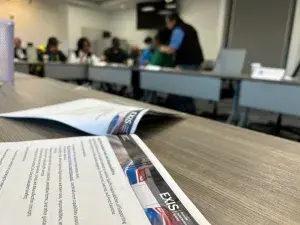
The simulated terrorist attack was escalating quickly!
From intruders in the county’s bus parking lot to suspicious backpacks on buses – vehicle-borne improvised explosive devices (IEDs) blew up, killing and wounding hundreds of passengers.
That’s how the day began for several department heads at northern Virginia’s Prince William County’s public OmniRide bus system, discussing how they would respond to a potential terrorist attack.
A TSA team of local Surface Transportation Security Inspectors (TSIs) built the scenario to help OmniRide management practice their response.
In developing this exercise, the TSIs used TSA’s Exercise Information System (EXIS®), an online exercise tool that guides government and industry users through the exercise design process. It offers a step-by-step approach as it leads users through exercise planning.
It assists in planning the scenarios and building and facilitating the exercise teams. The platform also helps share best practices and lessons learned. Using this system, local field offices conduct small-scale tabletop exercises, which are customized to individual partners’ real-time operations.
The local exercise in Virginia inspired the 14 participants “to think about their security-related policies and procedures that may need updating,” explained TSI Riley Flynn. “Perhaps they need to update some procedures or their recovery priorities or review their communications infrastructure. We were looking at their strengths, areas for improvements and overall options with the objective to strengthen their security posture.”
Flynn and the other TSIs, who facilitated the exercise, focused on ways OmniRide could help respond to, prevent and mitigate an attack, what they could do to protect their people and assets, and how to recover from such an event.
“We wanted to test their policies and procedures and push them to the point of the potential for failure in an effort to have them identify possible gaps they need to address to improve their security posture,” Flynn noted.
“This was a wonderful opportunity for OmniRide to pull their different departments together and work as a team to improve their teamwork and communications to help them identify any changes or improvements they might like to implement within their organization,” said Supervisory TSI (STSI) Josh Grey.
The larger scale Intermodal Security Training and Exercise Program, also known as I-STEP, is coordinated out of TSA headquarters and executed by field office inspectors with the direct support and engagement from headquarters employees and regional surface staff. I-STEP is designed to provide exercise, training and security planning tools and services to transportation providers. Some programs are large, full-day affairs facilitated by contractors, and others are shorter versions lasting just a few hours.
“The idea is to use these exercises to enhance security and reduce risk across the transportation network,” said Darrin McGreevy, the I-STEP coordinator for Surface Operations.
TSA conducts approximately 20 large-scale tabletop I-STEP exercises annually using contractors with about 100 additional smaller exercises administered by surface inspectors within their local regions, similar to the OmniRide exercise in November.
The program allows TSA to closely collaborate with transportation operators and enables security partners to continuously improve their overall levels of security preparedness and resilience. It not only provides support to small transit agencies, like the 160-bus OmniRide fleet but also offers exercise planning for big-city passenger and freight rail, pipeline, maritime, highway and motor carriers.
McGreevy’s team has worked with transportation providers to develop exercises for cities that have hosted the Super Bowl and in Washington, D.C., which hosts the presidential inauguration every four years.
They recently conducted one in Milwaukee to help prepare for next year’s Republican National Convention and one in Chicago where the Democratic National Convention will be held.
In those instances, “the idea was to develop scenarios that were focused on events involving large gatherings where a lot of people would be using mass transit, and then you throw in the possibility of protesters and counterprotesters,” McGreevy said.
I-STEP also offers workshops and how-to demos and seminars for TSA’s security partners. To learn more about I-STEP and EXIS, please visit Intermodal Security Training and Exercise Program | Transportation Security Administration (tsa.gov)
By Lisa Farbstein, TSA Strategic Communications and Public Affairs



